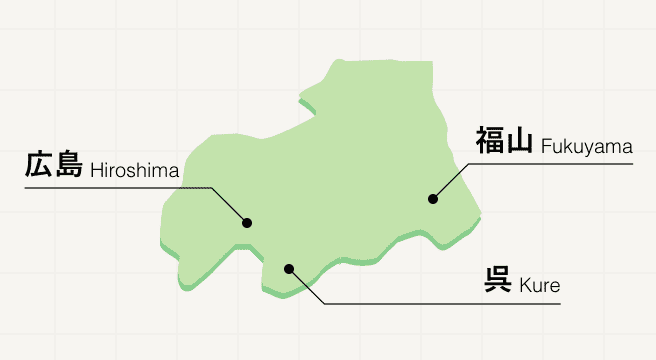Street Spots in Hiroshima Area
Area
-
-
Hiroshima
-
-
Hiroshima

Category


-
- Shimanami Kaido Cycling Road
- Travel / Tourism
- Hiroshima Onomichi-shi・Ehime Imabari-shi
-
- Neko no Hosomichi (Cat's Alley)
- Travel / Tourism
- Hiroshima Pref. Onomichishi Higashitsuchidouchou
- A narrow hill road some 200 meters long located close to Mt. Senkoji Ropeway Sanroku Station in Onomichi City, Hiroshima Prefecture. The alley is part of the setting of artist Shunji Sonoyama’s “Onomichi Ihatov” spatial project launched in 1997, and it functions as a road connecting old and dilapidated homes which have been renovated and remodeled into art museums, cafes, and restaurants. The area, surrounded by trees and other greenery and enwrapped in an old-fashioned atmosphere, is dotted with other 1,000 “Fuku-ishi-neko,” round stones painted with figures of lucky cats. For generations, large numbers of cats settle around this area, and the alley is also a popular tourism destination which attracts cat-lovers nationwide.
-
- Saijo Sakagura-dori Street
- Travel / Tourism
- Hiroshima Prefecture Higashihiroshima-shi
- Seven sake brewers are clustered together on this street in Saijo Ward, Higashi-hiroshima City. Saijo-style brewery buildings that have red brick chimneys as their trademark as well as retro-style buildings lining the street create a quaint atmosphere. They hold limited time events, and sake brewery tours with “Drunken Walk Ticket” are popular among the local people and tourists. Sake brewer tour is popular among locals and tourists.
-
- Senkoji Temple Path
- Travel / Tourism
- Hiroshima Pref. Onomichishi Higashitsuchidouchou
- A stone paved path in Onomichi City, Hiroshima Prefecture that runs almost two kilometers from Jikoji Temple, near JR Onomichi Station, eastwards to Kairyuji Temple. The road is lined with old shop, temples, and shrines, and with the stone walls lining the slopes of the road, you can truly experience Onomichi’s scenery as a town on a hill. It has frequently been used as a shooting location for films.
-
- Renga-dori Shopping District
- Travel / Tourism
- Hiroshima Kure-shi Chuo 4
- This shopping street is located a 10-minute walk from JR Kure Station. The street’s 400-meter-long arcade is paved with some 360 thousand bricks, and it is lined with a variety of well-known restaurants, souvenir shops, and other establishments. It is also famous for being the first shopping arcade in Japan to be covered by a retractable domed roof. Bustling with local shoppers, it is the busiest pedestrian thoroughfare in the city.
-
- Machiya Street
- Travel / Tourism
- Hiroshima Hatsukaichi-shi Miyajimacho
- This is one of three streets which connect the Miyajima ferry pier and Itsukushima Shrine. This particular street was the main thoroughfare when Miyajima was at its most prosperous. The traditional townhomes along the street have had modern touches added onto them, and the street is dotted with old-fashioned mom-and-pop businesses and private homes, as well as retro-modern lodging facilities, shops, and galleries. Itsukushima Shine’s magnificent five-story pagoda stands at the end of the street. Today, the street is primarily used by local residents as part of everyday life. At night, the street is illuminated by the light of paper lanterns installed under the eaves of the various establishments along its length, engendering a romantic atmosphere quite different from how the street feels in the daytime.
-
- Kannabe
- Travel / Tourism
- Hiroshima Fukuyama-shi Kannabecho Kawakita
- Kannabe-cho in Fukuyama City still retains many traces of the Edo period, and in the past it once flourished as the junction between the San’yo Road, Iwami Silver Mine Road, and Kasaoka Road. It is also believed to have been the center of politics and finance in Bingo Province in the early Edo period until the construction of Fukuyama Castle. Many samurai lords are said to have made use of the town while making the required journey to reside in Edo every other year, and the honjin stronghold and many merchant homes which still stand in the area today recall this bustling period. The area’s extant honjin was designated an Important Cultural Property by Hiroshima Prefecture in 1969. Originally there were two honjin, but today only the western honjin remains.
-
- Museum of Art Dori
- Travel / Tourism
- Hiroshima Kure-shi Saiwaicho
-
- Towanomichi
- Travel / Tourism
- Hiroshima Pref. Hiroshimashinakaku Otemachi
Hiroshima Areas

There is more than meets the eye awaiting any Hiroshima-bound traveler. Kicking off in Hiroshima city, the Peace Memorial Park, Hiroshima Castle, and Shukkeien Garden offer a couple of days of exploring; however, the real beauty lies along the southern coast of the prefecture. There, a series of islands spreads across the Seto Inland Sea: from the mysterious sea-submerged Great Torii Gate at Miyajima Island to the first half of the islands that connect Honshu to Shikoku via six spectacular suspension bridges.
Best of Hiroshima
Search by Region
-
- Hokkaido / Tohoku
- Hokkaido
- Aomori
- Iwate
- Miyagi
- Akita
- Yamagata
- Fukushima
-
- Kanto
- Ibaraki
- Tochigi
- Gunma
- Saitama
- Chiba
- Tokyo
- Kanagawa
-
- Koshinetsu / Hokuriku
- Niigata
- Toyama
- Ishikawa
- Fukui
- Yamanashi
- Nagano
-
- Tokai
- Gifu
- Shizuoka
- Aichi
- Mie
-
- Kinki
- Shiga
- Kyoto
- Osaka
- Hyogo
- Nara
- Wakayama
-
- Chugoku
- Tottori
- Shimane
- Okayama
- Hiroshima
- Yamaguchi
-
- Shikoku
- Tokushima
- Kagawa
- Ehime
- Kochi
-
- Kyushu / Okinawa
- Fukuoka
- Saga
- Nagasaki
- Kumamoto
- Oita
- Miyazaki
- Kagoshima
- Okinawa


















